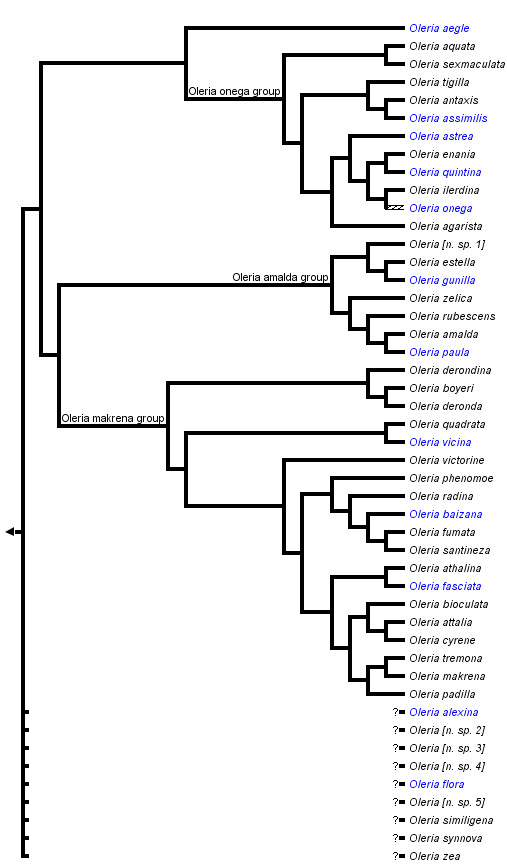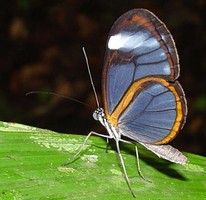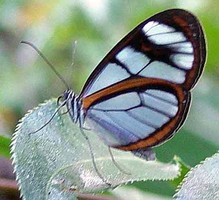Oleria TS = Papilio astraea Cramer, 1775
Andrew V. Z. Brower


This tree diagram shows the relationships between several groups of organisms.
The root of the current tree connects the organisms featured in this tree to their containing group and the rest of the Tree of Life. The basal branching point in the tree represents the ancestor of the other groups in the tree. This ancestor diversified over time into several descendent subgroups, which are represented as internal nodes and terminal taxa to the right.

You can click on the root to travel down the Tree of Life all the way to the root of all Life, and you can click on the names of descendent subgroups to travel up the Tree of Life all the way to individual species.
For more information on ToL tree formatting, please see Interpreting the Tree or Classification. To learn more about phylogenetic trees, please visit our Phylogenetic Biology pages.
close boxIntroduction
A diverse group of delicate mimetic butterflies from Central and South America. Many of the species exhibit geographical variability in their wing patterns. Larvae are cryptic green, and feed on various species of Solanaceae. It is likely that the adults gain their unpalatability from pyrrolizidine alkaloids gathered by nectaring from flowers of various Compositae.Discussion of Phylogenetic Relationships
Tree based on the molecular phylogenetic study of de Silva et al. (2010). Some taxa, such as Oleria onega, are paraphyletic and probably represent more than one species. The unplaced taxa at the bottom represent species not included in the de Silva et al. analysis.References
Brown KS, Jr., and Freitas AVL. 1994. Juvenile stages of Ithomiinae: overview and systematics. Tropical Lepidoptera 5: 9-20.
De Silva, D. L., Day, J. J., Elias, M., Willmott, K., Whinnett, A. & Mallet, J. 2010. Molecular phylogenetics of the neotropical butterfly subtribe Oleriina (Nymphalidae: Danaini: Ithomiini). Mol. Phylogenet. Evol. 55, 1032-1041.
Lamas G ed. 2004. Atlas of Neotropical Lepidoptera. Checklist: Part 4A Hesperioidea - Papiionoidea. Gainesville: Scientific Publishers/Association of Tropical Lepidoptera.
Neild, A. F. E. 2008 The Butterflies of Venezuela. Part 2: Nymphalidae II (Acraeinae, Libytheinae, NYmphalinae, Ithomiinae, Morphinae). London: Meridian Publications.
Title Illustrations

| Scientific Name | Oleria paula |
|---|---|
| Location | Selva Negra, Nicaragua |
| Acknowledgements | source: Neotropical Butterflies: Thick-rimmed Clearwing |
| Specimen Condition | Live Specimen |
| Source Collection | Neotropical Butterflies |
| Copyright | © 2003 Richard Lehman |
| Scientific Name | Oleria egra |
|---|---|
| Location | Rio Parauri, Amazonas, Brazil |
| Acknowledgements | source: Neotropical Butterflies: Egra Clearwing |
| Specimen Condition | Live Specimen |
| Source Collection | Neotropical Butterflies |
| Copyright | © 2002 Will and Gill Carter |
| Scientific Name | Oleria astrea |
|---|---|
| Location | Maues, Amazonas, Brazil |
| Acknowledgements | source: Neotropical Butterflies: Astrea Clearwing |
| Specimen Condition | Live Specimen |
| Source Collection | Neotropical Butterflies |
| Copyright | © 2002 Will and Gill Carter |
About This Page

Middle Tennessee State University, Murfreesboro, Tennessee, USA
Correspondence regarding this page should be directed to Andrew V. Z. Brower at
Page copyright © 2010
 Page: Tree of Life
Oleria TS = Papilio astraea Cramer, 1775.
Authored by
Andrew V. Z. Brower.
The TEXT of this page is licensed under the
Creative Commons Attribution License - Version 3.0. Note that images and other media
featured on this page are each governed by their own license, and they may or may not be available
for reuse. Click on an image or a media link to access the media data window, which provides the
relevant licensing information. For the general terms and conditions of ToL material reuse and
redistribution, please see the Tree of Life Copyright
Policies.
Page: Tree of Life
Oleria TS = Papilio astraea Cramer, 1775.
Authored by
Andrew V. Z. Brower.
The TEXT of this page is licensed under the
Creative Commons Attribution License - Version 3.0. Note that images and other media
featured on this page are each governed by their own license, and they may or may not be available
for reuse. Click on an image or a media link to access the media data window, which provides the
relevant licensing information. For the general terms and conditions of ToL material reuse and
redistribution, please see the Tree of Life Copyright
Policies.
- First online 29 September 2006
- Content changed 21 July 2010
Citing this page:
Brower, Andrew V. Z. 2010. Oleria TS = Papilio astraea Cramer, 1775. Version 21 July 2010 (under construction). http://tolweb.org/Oleria/27611/2010.07.21 in The Tree of Life Web Project, http://tolweb.org/











 Go to quick links
Go to quick search
Go to navigation for this section of the ToL site
Go to detailed links for the ToL site
Go to quick links
Go to quick search
Go to navigation for this section of the ToL site
Go to detailed links for the ToL site